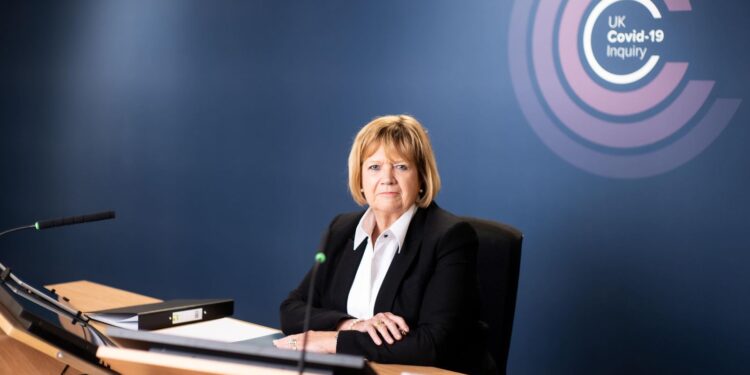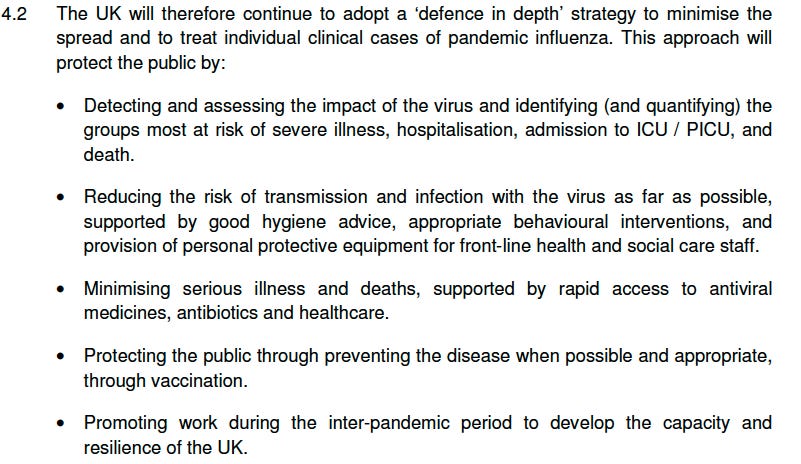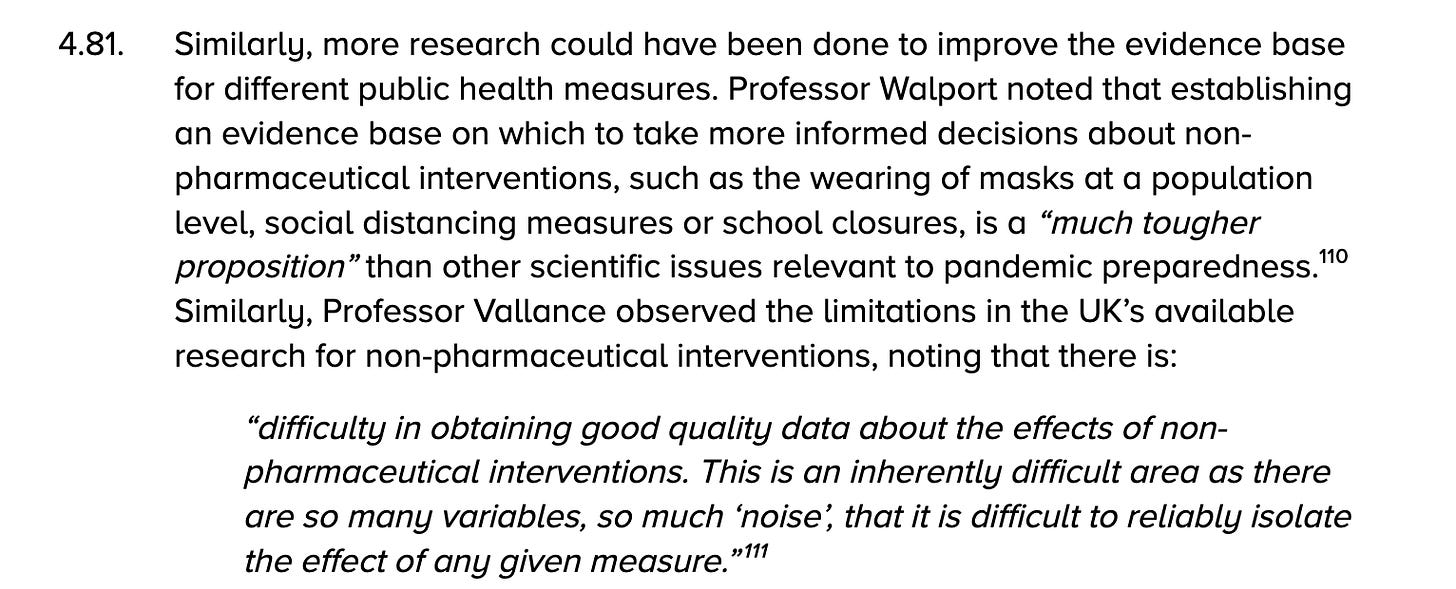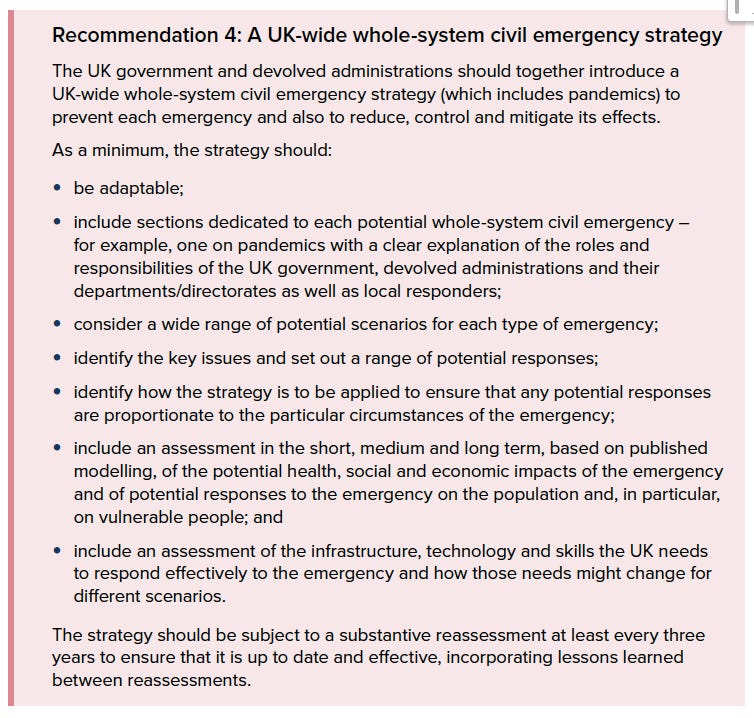In the words of the report:
Superficially, this looks clear and in logical order.
Let’s start with the 2011 preparedness plan. The inquiry correctly identifies the focus on a single pathogen (influenza) as one reason for its irrelevance. We would qualify that as the main reason, together with the underlying box thinking.
The U.K. 2011 plan was inspired by the U.S. HHS Pandemic plan, which contained several “critical assumptions”.
Specific assumptions for antiviral drugs include: “Treatment with a neuraminidase inhibitor (oseltamivir [Tamiflu®] or zanamivir [Relenza®]) will be effective in decreasing risk of pneumonia, will decrease hospitalisation by about half (as shown for interpandemic influenza), and will also decrease mortality.”
The Hallett report fails to mention that the plan’s essence was based on the mass use of antivirals (stockpiled at great public expense) to ‘hold the fort’ until influenza pandemic vaccines became available. In the 2009 influenza pandemic, neither was needed and subsequently, when the evidence base for both interventions was shown to be biased and wholly inadequate, no notice was taken despite extensive media coverage.
The pervasive problem with all of these plans is the false confidence that interventions will benefit those who adhere to them. Antivirals have no impact on hospitalisations or mortality unless you look at the infamous industry-funded Kaiser meta-analysis.
In 2016, the U.K. carried out a National Pandemic Flu Exercise to assess its preparedness and response to pandemic influenza, which was close to the U.K.’s reasonable worst-case planning scenario.
The evaluation of the exercise highlighted the strengths of existing plans and U.K. command and control emergency response structures and identified areas where resilience could be further enhanced. Beyond overconfidence, a second fatal flaw in preparedness plans is the arrogance all is well. Inexperienced ministers are looked down on by a system that pretends it is prepared. Groupthink coalesces to provide reassuring messages failing to acknowledge the uncertainties and the lack of evidence to inform decision-making. Consequently, ministers, lacking experience and expertise at the time, are kept in the dark by the reassurance of their advisers.
The inquiry stated, “It is obvious, on the face of the 2011 Strategy, that the UK had devoted its efforts to preparing for an influenza pandemic. Professor Dame Sally Davies, Chief Medical Officer for England from June 2010 to October 2019, could not recall a debate about including non-influenza pandemics in the 2011 Strategy.”
The U.K.’s approach to pandemic and inter-pandemic influenza preparedness psychologically locked the whole world on a single agent but also implied that “normality” was the inter-pandemic time between inevitable further pandemics, which, according to the then-WHO definition, meant widespread death and destruction.
As we pointed out repeatedly, attention to a single pathogen in the best cases (i.e., where there was no commercial intent) indicates the inadequacy and ignorance of those at the helm, specifically Dame Sally Davies and her predecessor Sir Liam Donaldson and in the U.S. Senator Hillary Clinton pushing a bill to protect the U.S. against “the flu”, another interesting and distorting use of the F word.
In the 2011 plan, chapter 4 (which you can read from page 34 of the 70-page document), the “Key Elements of the Pandemic Response” are listed as follows:
You will note the article “the” in front of the word “virus”. In addition, paragraph 4.15 refers to public face mask-wearing.
Despite the uncertainty surrounding the use of masks and some of the other remedies, the DHSC made no effort to commission large, well-designed trials that could diminish that uncertainty. As we all know, the 2011 plan was thrown out of the window post haste when the Government was confronted with mass panic in the spring of 2020.
Paragraph 4.81 highlights the contradiction in the “groupthink” advice.
Contrast this with Sir Mark Walport’s statements to the press:
There is sufficient evidence to conclude that early, stringent implementation of packages of complementary NPIs was unequivocally effective in limiting SARS-CoV-2 infections.
Walport’s review in the Royal Society of Medicine stated: “Lockdowns and face masks ‘unequivocally’ cut spread of Covid.”
Statements of “Sufficient evidence to conclude” and “unequivocally” contradict any need to improve the evidence base for these measures. It’s a shame the inquiry, with all its resources at hand, didn’t pay attention to the irreconcilable statements arising from the group thinkers.
The argument that it is difficult to obtain “good quality data” is a distractor. Evidence-based medicine is hard and requires rigour and, more importantly, funding to address the uncertainties. Pandemics sit outside the norms of how we develop evidence, largely because those at the helm have no idea how rational evidence-based healthcare works.
In paragraph 4.27 paragraph, High Consequence Infectious Diseases (HCIDs) are further raised.
It is not apparent to the Inquiry why the strategies for high consequence infectious diseases and pandemics were so different and disconnected from each other. They ought to have been considered together. If they had, then systems that were routine for high consequence infectious diseases (such as test, trace and isolate) would have been scalable and ready to control the spread of a novel virus with pandemic potential.
The inquiry presumes the answer lies elsewhere. If only we had done XXX. Yet, where is the evidence that test, trace and isolate works to control the spread of an agent and at what health economic cost, given it ended up costing £37 billion? More so, how does the plan apply when the pathogen is immediately downgraded from an HCID?
So what does Lady Hallett propose now? The irony is that the only person cited in the report advocating trials is the arch modeller, Sir John Edmunds. Well, that’s good for him, but he’s forgetting that his models will now have to be premised on RCT evidence and not made up based on assumptions.
“The Inquiry acknowledges that improving the evidence base for such public health measures is not straightforward and requires much more thought within the scientific community.” Turning to the same old group of people won’t solve the problem of having too little evidence to inform decision-making.
Here are the two recommendations:
and
None of these ideas are new. For example, “hibernation” was the mechanism by which pre-pandemic influenza vaccines were developed 20 years ago and then underwent reconfiguration, limited testing and emergency registration on September 27th 2009.
There is no mention of “inter-pandemic” evidence development, health economics, or an assessment of the interventions in the pandemic and their role in future pandemics. The chapter is supposed to be about an “effective strategy”. Yet, box-thinking continues.
This post was written by two old geezers who will not charge you £190,000 a day.
Dr. Carl Heneghan is the Oxford Professor of Evidence Based Medicine and Dr. Tom Jefferson is an epidemiologist based in Rome who works with Professor Heneghan on the Cochrane Collaboration. This article was first published on their Substack, Trust The Evidence, which you can subscribe to here.


















To join in with the discussion please make a donation to The Daily Sceptic.
Profanity and abuse will be removed and may lead to a permanent ban.
“Walport’s review in the Royal Society of Medicine stated: “Lockdowns and face masks ‘unequivocally’ cut spread of Covid.””
For the benefit of anyone new, I don’t care whether they did anything of the sort, whatever could be meant by those words. Cut from what to what, at what cost, and what benefit? If “covid” exists then it’s a bad cold/flu. I’m not staying at home for that, nor am I wearing stupid nappy on my face. I don’t care if they work, the cost is far too high. Bring me the Black Death and I will concede we should interrupt normal life for a while, but not for “covid”.
As you know it was the CCP that locked down the Chinese Province of Wuhan along with mandating masks and mass testing. They also welded some people into their homes, while also forcibly removing others. They built emergency hospitals in days and dug mass graves using JCBs in preparation for the huge death tole. The WHO (and Gates) asserted that the CCP had done a good job controlling this virus with the intimation that the entire planet must copy China (see some evidence in Video below). Later on China introduced a ‘much better’ anal swab test, perhaps to see if they could get the rest of the world to follow China again and properly humiliate themselves.
No one checked whether anything China claimed was true and it didn’t seem to bother our leaders that China had locked down just one province even though the virus had escaped to the rest of the World. Miraculously, most of China remained free of the virus and remained open and it’s industries unaffected. All the tests and masks were made in China.
In the video below Kate Wand exposes Anthony Fauci’s connection with the CCP. It’s only 7 mins long and all worth listening to, IMHO. There is mush insistence that the world must not open up too soon and towards the end the Chinese Professor states that natural immunity will not work because it is unrealistic less scientific and inhumane.
https://www.youtube.com/watch?v=cb-JExoBhmU
Fauci Follows ‘the Science’ | Kate Wand
Not forgetting, those who went to the pub were safe – only if they ate a substantial meal such as a scotch egg 🙄
For me that was the ultimate “jump the shark” moment when anyone who was going to wake up would surely have woken up.
We had lunch with some normies we haven’t seen for a few years the other day and at a certain point they started talking about bubbles.
‘They’ really played and ridiculed the populace didn’t they – and unfortunately, far too many failed the common sense test.
As long as you were sitting down.
If people would be ‘safe’ from a killer virus by eating a scotch egg – sitting down – why did the country go on a jabathon, jabbing the masses? People could have been encouraged to consume a scotch egg – daily – to the saying ‘a scotch egg a day keeps the doctor away’…or ‘a scotch egg a week makes BigPharma weep’ 🙂
Absolutely spot on TOF. We decide if the cost is acceptable or not, individually, not our Servants from on high.
Stop infantalising us and let us make our own informed (or even ignorant) decisions. We have a right to choose the wrong choice, as long as it is OUR choice.
The trouble is a lot of our fellow citizens seem to want to be treated as infants and worse than that they want us to be treated as infants too – equality!
I do believe the latter group are a tiny, but very vocal and MSM promoted minority.
Zealots supporting whatever agenda
Far from tiny – expecting/wanting/hoping the state/government to solve all or many of your problems is pretty common in my experience.
I meant the group that want the government to dictate to everyone, not just their lemming selves, but you could be right!
Most covidians I spoke to back in the day were quick to condemn anyone “breaking the rules”.
The situation is exactly the same in New Zeeland and they are prepared to do it all again:
https://www.malone.news/p/new-zealand-lets-do-the-time-warp
My experience as an educator has taught me that change begins within. It is our inner experience that enables us to gain perspective, to re-evaluate and change gear. This is the need of our time.
This point was forcibly driven home for me this week when I read the “New Zealand Pandemic Plan: A Framework For Action.” This document has just been published by Health New Zealand, which is laying out NZ policy in the event that the WHO declares another pandemic. It is a prime example of an aspiring cabal of policy wonks stuck in the past, unable to change gears and move forward. For 211 pages, the document rambles on rubber stamping all the mistakes of the COVID-19 pandemic response. It dictates that in the near future we will do it all again—lockdowns, masks, vaccines, antivirals, mandates, social distancing, isolation, school and business closures, and censorship of media content…
…Most chilling of all, the policy recognizes the power of a medical officer of health, in conjunction with the police, to detain persons in isolation by force and to continue to do so until necessary prescribed preventive treatment has been administered. You know what that means.….
Same reason the powers that be won’t investigate the destruction of nordsteam 2, or verify who actually voted for Biden in 2020 when the film 2000 mules shows ballot harvesting to drop boxes in swing states. If something is ignored one can almost be sure it is true. Get ready for another bout of vote rigging in 2024 via these mail in ballots without ID checks.
One way would be another ‘new’ virus followed by lockdowns and all voting becomes electronic.
Basic modelling shows that lockdowns result in lower acquired immunity leading to second waves. https://osf.io/y6ckv/
A cynic might suggest that if they say lockdowns are useless, they can’t do it to us again…
Well done, the two old geezers. It is worth listening to old geezers, could save huge sums of money. The taxpayer has already paid for all knowledge that might be required in this area by means of another astute old geezer. He was called D.A.J. Tyrrell and he ran the Common Cold Unit.
Regarding treatment of the common cold, he mentions:
‘local hyperthermia (inhaling water-saturated air at 43°C) has an immediate effect in improving symptoms but also a lesser effect that lasts a few days.’
Hyperthermia has, I believe, been used since Roman times, if not before.
He does not mention ‘lockdowns’ but gives us a clue as to the likely effectiveness of isolation:
‘…it was shown that colds could be transmitted from one end of a long room to the other when only air contact was possible…In recent careful experimental work, manual transmission in a group playing poker was prevented by using splints or large plastic collars; yet rhinovirus infection was freely transmitted, so the airborne route must have been of major importance in those circumstances’
He also indicates the major problem with vaccines:
‘This essay has focussed mainly on rhinoviruses, as the main cause of common colds. However, we know that coronaviruses as well as paramyxoviruses or enteroviruses also make a small but significant contribution, and there is a substantial fraction due to as yet unidentified organisms (Larson et al., 1980). This means that even if a highly effective specific rhinovirus treatment were developed it would provide no benefit for many colds.’
What, then, to do? Mr Tyrrell has a straightforward answer:
‘It is therefore arguable that in the case of infections like coronavirus or rhinovirus colds, which are normally quickly self-limited, the best approach would be to relieve the patient’s discomfort and disability and leave their immune system to take care of the virus.’
https://www.sciencedirect.com/science/article/pii/016635429290032Z
We knew what to do. We had been doing it for millennia. It worked.
Unfortunately, as far as the dimwits in government (and now in this silly, ruinously expensive, inquiry) were concerned, this was not an unknown unknown, not even a known unknown, but, apparently, an unknown known……
Oh for heaven’s sake!
Spot on. It’s instructive to review what was done there in Salisbury, out to about 1989. They actually invented the term “coronavirus” as well, having detected them using election microscopy, which was quite new in the late 1940s.
“….ministers, lacking experience and expertise at the time, are kept in the dark by the reassurance of their advisers.” Isn’t that most of them, much of the time, especially if they change their jobs reasonably often? The Permanent Secretaries and the staff call the shots, most of the time, as long as it’s capable of being sold politically.
There are certain things that are diffiult to admit. There willl be no lockdown enquiry or anything like it. Maybe if we had a revolution and a simultaneous jump to a higher level of consciousness but that aint happening.
Because the RPTB.
“Let’s start with the 2011 preparedness plan. The inquiry correctly identifies the focus on a single pathogen (influenza) as one reason for its irrelevance.”
Wow. If that 2011 plan had been followed, the outcome would have been dramatically better than the fiasco we actually saw. That plan basically recommended what Sweden did.
This whole thing is ridiculous now. Everyone can see the events of 2020 were actually a national security response to the escape of an artificial pathogen from the US bio weapon research programme in Wuhan.